Niger, a landlocked country in West Africa, is home to a variety of amazing birds. From the majestic crowned crane to the colorful yellow-billed shrike, the birds of Niger have captivated nature lovers from around the world.
With over 500 species of birds, including both resident and migratory species, Niger’s birds are a delight for birdwatchers and ornithologists alike. This introduction provides an overview of the different birds that can be found in Niger, their habitats, behaviors, and conservation status.
1. Hamerkop
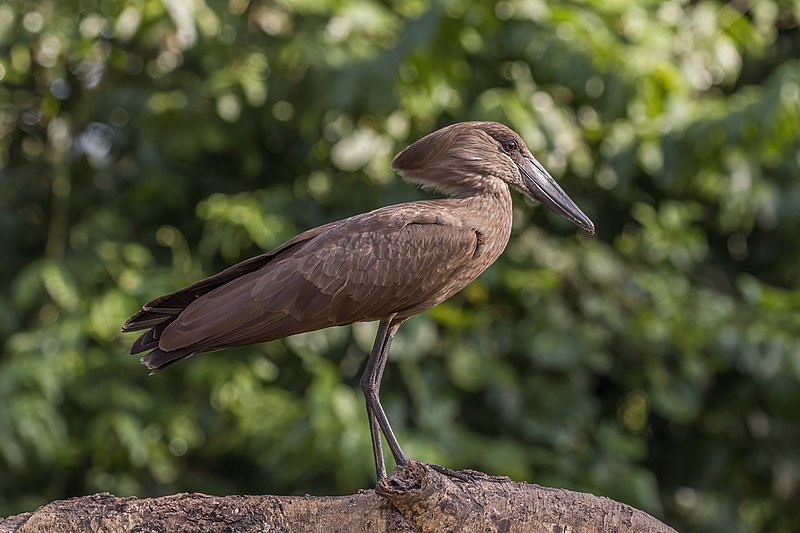
The Hamerkop is a unique wading bird found across sub-Saharan Africa and as far east as India.
It has an unmistakable silhouette, with its long bill topped by a crest at the back of its head that gives it the look of a hammerhead shark.
Its plumage consists mainly of browns and greys, providing excellent camouflage in reed beds.
The species was once classified alongside storks but is now believed to be closely related to pelicans and shoebills instead.
This medium-sized bird feeds on insects, fish, frogs or small reptiles which it captures from shallow water or plucks from trees near bodies of water.
Despite being considered ‘unlucky’ by some cultures due to superstition surrounding their appearance they are actually quite important for controlling populations of certain pests.Scientific classification:
| Kingdom | Animalia |
| Phylum | Chordata |
| Class | Aves |
| Order | Pelecaniformes |
| Family | Scopidae |
| Genus | Scopus |
| Species | S. umbretta |
2. African Grey Hornbill
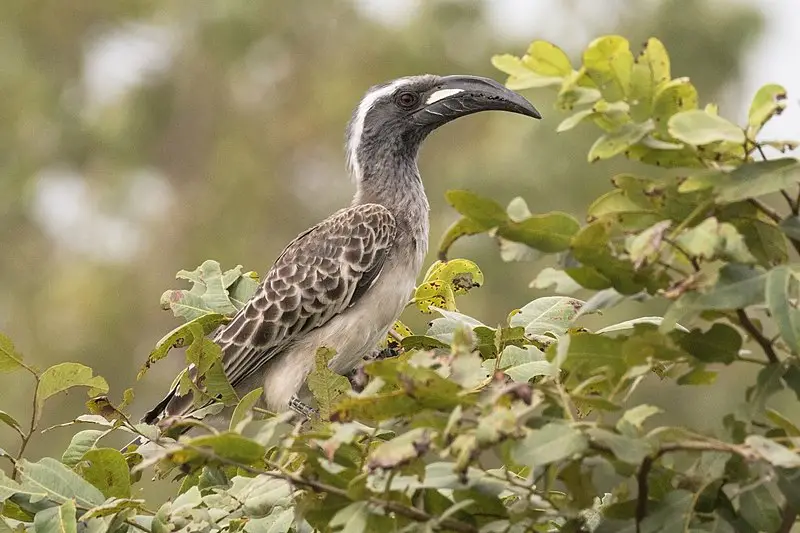
The African grey hornbill is a large bird with striking black and white plumage. Its most recognizable feature is its long, down-curved bill which has a red base and yellow tip.
They are found in sub-Saharan Africa as well as Arabia and have been known to escape or be released into Florida where they may not be breeding yet.
Their diet mainly consists of fruits, insects, small reptiles and amphibians making them important seed dispersers for their habitats.
Hornbills play an important role in the ecosystem by controlling pests like locusts while also providing food for predators such as eagles or larger cats.
These birds are often kept as pets but can become very demanding due to their intelligence so potential owners should do research before considering one of these amazing creatures.Scientific classification:
| Kingdom | Animalia |
| Phylum | Chordata |
| Class | Aves |
| Order | Bucerotiformes |
| Family | Bucerotidae |
| Genus | Lophoceros |
| Species | L. nasutus |
3. Senegal Coucal
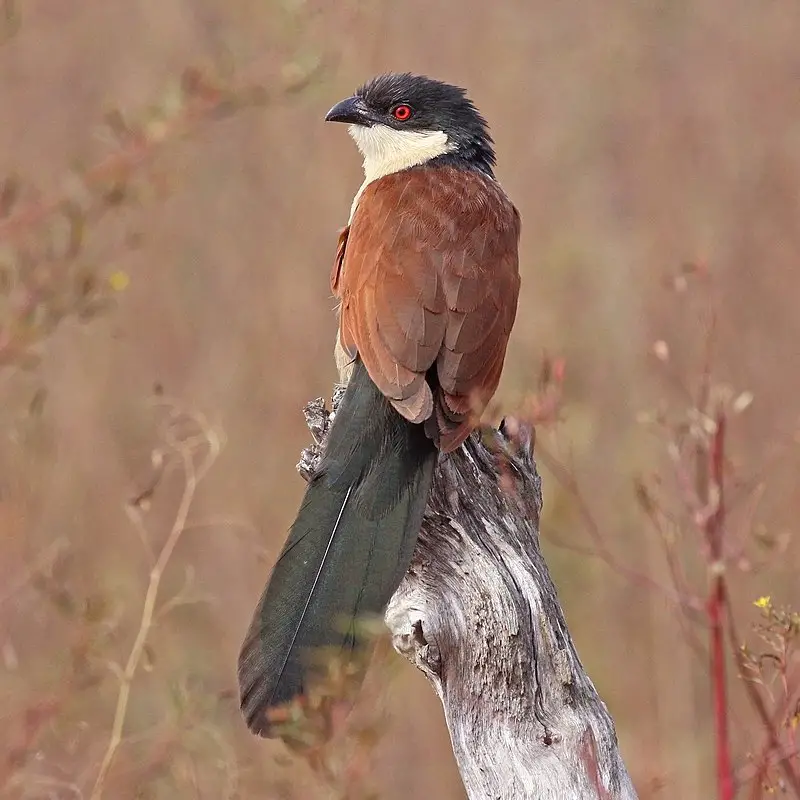
The Senegal coucal is a cuckoo-like bird native to Central and Southern Africa. It has a medium-sized body with black wings, tail and head along with white breast feathers.
Its natural habitat consists of lightly wooded savannahs where it feeds on insects, small reptiles, amphibians and fruits.
This species can be found in pairs or alone atop low bushes searching for prey or perched up high singing its distinctive song that features a mix of harsh notes as well as melodic ones.
The Senegal coucal enjoys the sun’s rays but also loves sheltering in dense vegetation when danger arises nearby.
Overall this beautiful bird makes an interesting addition to any backyard garden.Scientific classification:
| Kingdom | Animalia |
| Phylum | Chordata |
| Class | Aves |
| Order | Cuculiformes |
| Family | Cuculidae |
| Genus | Centropus |
| Species | C. senegalensis |
4. Water Thick-Knee
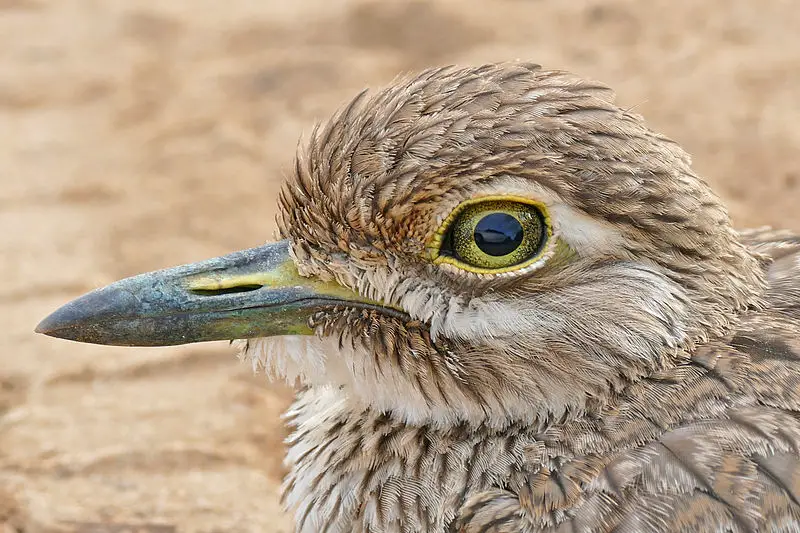
The Water thick-knee is a species of bird belonging to the Burhinidae family. It has a wide distribution in sub-Saharan Africa, where it can be found near waterbodies such as rivers, lakes and wetlands.
Its plumage is dark brown above with white spots on its wings, while below it is mostly greyish or whitish.
The bill is long and straight with yellow legs and feet. During breeding season they are more vocal than usual making loud calls during the night time hours that sound like “keh keh”.
This bird feeds mainly on insects but also takes small reptiles, crustaceans and molluscs from shallow waters when available.
Breeding pairs construct scrapes within grassy areas which they use for nesting sites during the dry season months between July to September depending on locationScientific classification:
| Kingdom | Animalia |
| Phylum | Chordata |
| Class | Aves |
| Order | Charadriiformes |
| Family | Burhinidae |
| Genus | Burhinus |
| Species | B. vermiculatus |
5. Red-Throated Bee-Eater
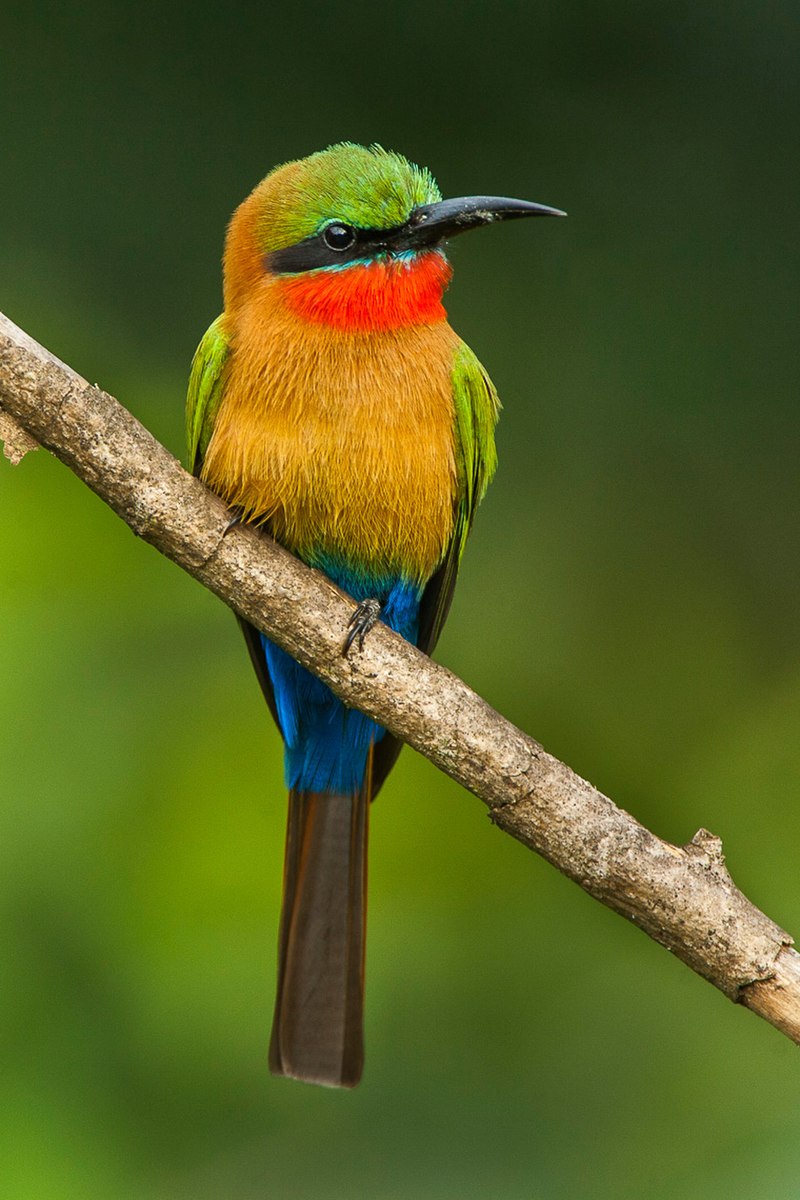
The Red-throated Bee-eater is a beautiful species of bird found in tropical Africa. It has bright red feathers covering its throat, giving it a distinct look.
Its body is mostly brown with white stripes and its wings are dark blue on the tips.
This species enjoys an extensive range throughout countries like Benin, Burkina Faso, and Togo to name just a few.
These birds feed mainly on insects that they catch in midair or from nearby foliage during their hunting flights over open country habitats such as woodlands and savannas.
While not much else is known about this particular type of bee-eater, these colorful creatures have surely become quite popular due to their striking beauty.Scientific classification:
| Kingdom | Animalia |
| Phylum | Chordata |
| Class | Aves |
| Order | Coraciiformes |
| Family | Meropidae |
| Genus | Merops |
| Species | M. bulocki |
6. Bee-Eater

Bee-eaters are one of the most beautiful and vibrant birds in existence. They have a slender body, long wings, down turned bills and their signature elongated central tail feathers which make them instantly recognizable from afar.
Their plumage is incredibly colorful with many shades ranging from blues to greens to reds that glisten when they fly through the air.
These stunning creatures can be found all over Africa, Asia, Southern Europe, Australia and New Guinea where they feed mainly on bees but also other insects like flies or wasps as well as small mammals such as lizards or rodents.
Bee-eaters live in colonies near rivers or wetlands so that they may easily hunt for food while staying close together for safety purposes.
Additionally it allows them to better display their impressive courtship dances during mating season.Scientific classification:
| Kingdom | Animalia |
| Phylum | Chordata |
| Class | Aves |
| Order | Coraciiformes |
| Family | Meropidae Rafinesque, 1815 |
7. Beautiful Sunbird
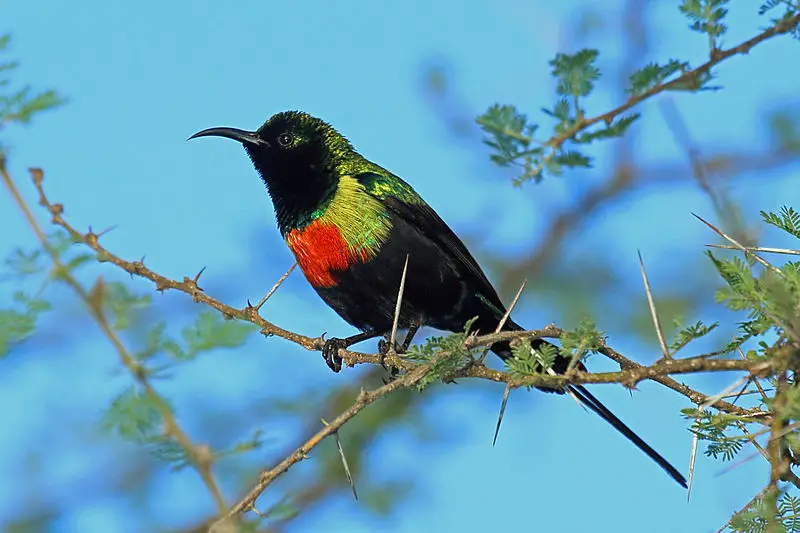
The Beautiful sunbird is a small and colorful bird, native to tropical Africa. It measures roughly 10 cm in length, with the breeding male’s long tail adding an extra 5 cm.
Its plumage has shades of yellow-green on its back and head, while its breast and belly are usually orange or red depending on their location.
These birds have thin down curved beaks that help them feed from flowers for nectar as well as insects like flies, moths, bees and beetles which they catch in midair with acrobatic tricks.
They typically live alone but during mating season form pairs and build nests out of grasses woven together using spider webs at the base of trees or shrubs close to water sources.
The males display vibrant colors when courting females by rapidly flicking their wings open then closed again before soaring away in flight.Scientific classification:
| Kingdom | Animalia |
| Phylum | Chordata |
| Class | Aves |
| Order | Passeriformes |
| Family | Nectariniidae |
| Genus | Cinnyris |
| Species | C. pulchellus |
8. Abyssinian Roller
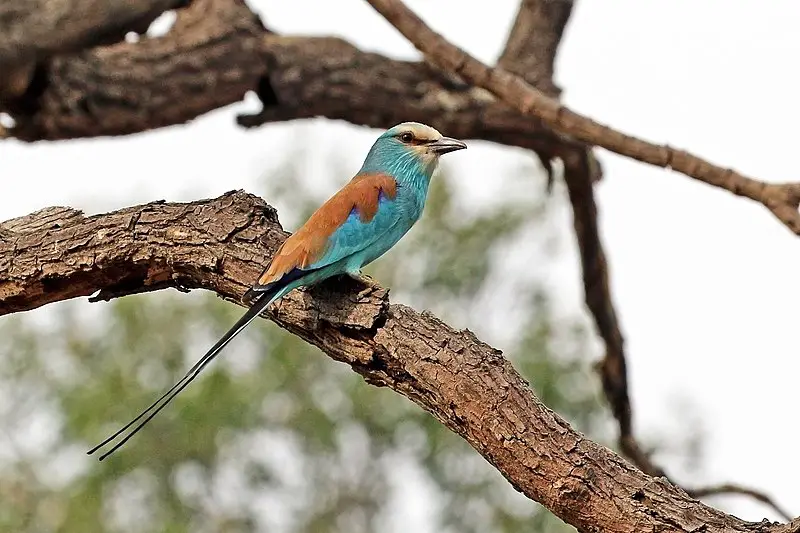
The Abyssinian roller is a large bird, nearly 28 cm in length. It has an unmistakable plumage of bright blue upperparts with chestnut underparts and wings.
Its head is blackish-blue and its tail feathers are white tipped giving it a striking appearance when seen in flight.
This species breeds across tropical Africa from the Sahel belt south of the Sahara desert to East Africa.
Northern populations tend to migrate short distances after wet season while southern ones stay resident throughout year.
They feed mainly on insects which they catch by hovering over fields or open woodland before diving down onto their prey below them.
In addition, they also eat small reptiles, amphibians and rodents along with fruits such as figs occasionally too.Scientific classification:
| Kingdom | Animalia |
| Phylum | Chordata |
| Class | Aves |
| Order | Coraciiformes |
| Family | Coraciidae |
| Genus | Coracias |
| Species | C. abyssinicus |
9. Cream-Colored Courser
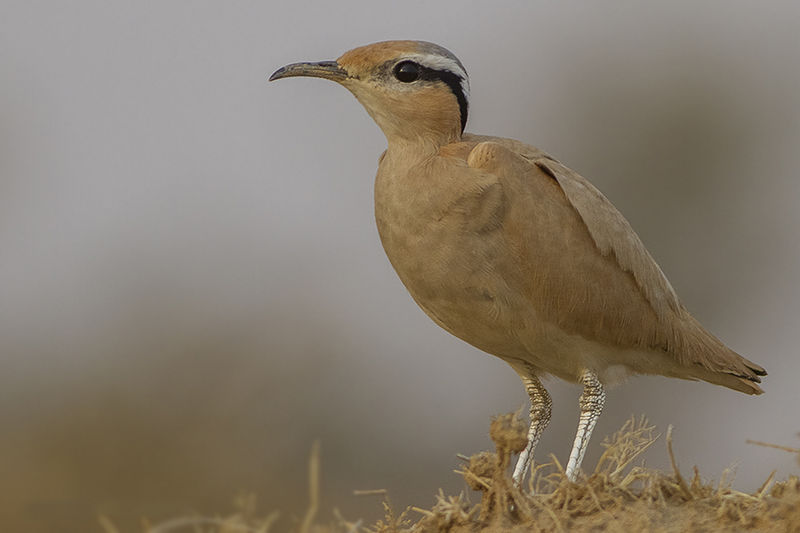
The Cream-colored Courser is a species of wader belonging to the Glareolidae family. It can be found across Western Asia and North Africa and inhabits dry, open semi-desert habitats.
These birds have adapted well to their environment; they are able to run quickly in search of insect prey on the ground which explains their scientific name Cursorius cursor – derived from Latin for ‘runner’.
The coursers also inhabit the Canary Islands as well as Cape Verde where breeding occurs during summer months before migration back south begins in autumn and winter months.
They are easily identified by their distinctive cream coloration with brown streaking along wings, neck and chest region making them an important part of these arid ecosystems.Scientific classification:
| Kingdom | Animalia |
| Phylum | Chordata |
| Class | Aves |
| Order | Charadriiformes |
| Family | Glareolidae |
| Genus | Cursorius |
| Species | C. cursor |
10. Hoopoes
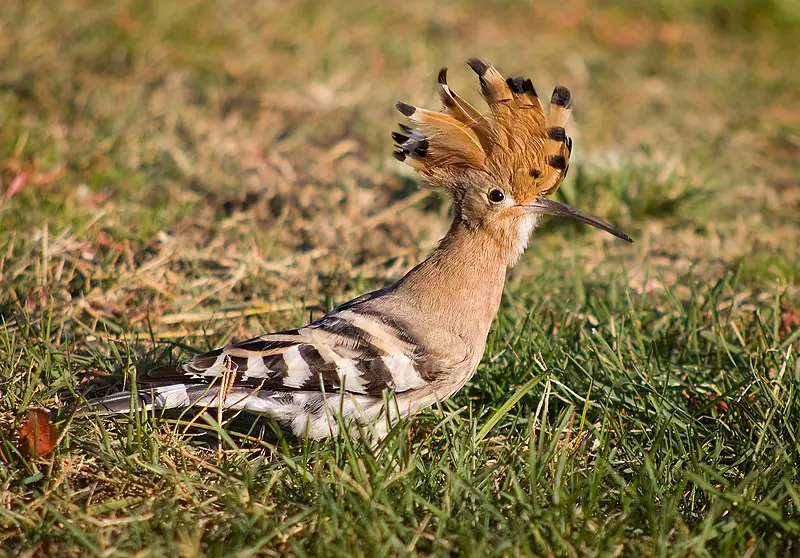
Hoopoes are a fascinating species of bird, found across Africa, Asia and Europe. They have beautiful plumage with unique ‘crowns’ of feathers on their heads.
Three living and one extinct species exist – although for some time they were all classed as the same species: Upupa epops. Some taxonomists still believe this to be true.
These birds are often associated with royalty due to the impressive crown-like crest atop their head, adding an extra element of mystery and exoticism to these creatures.
Hoopoes can also produce loud calls which sound like “hoo-poo” hence why they’ve been given such an apt name.Scientific classification:
| Kingdom | Animalia |
| Phylum | Chordata |
| Class | Aves |
| Order | Bucerotiformes |
| Family | Upupidae Leach, 1820 |
| Genus | Upupa Linnaeus, 1758 |
11. Turaco
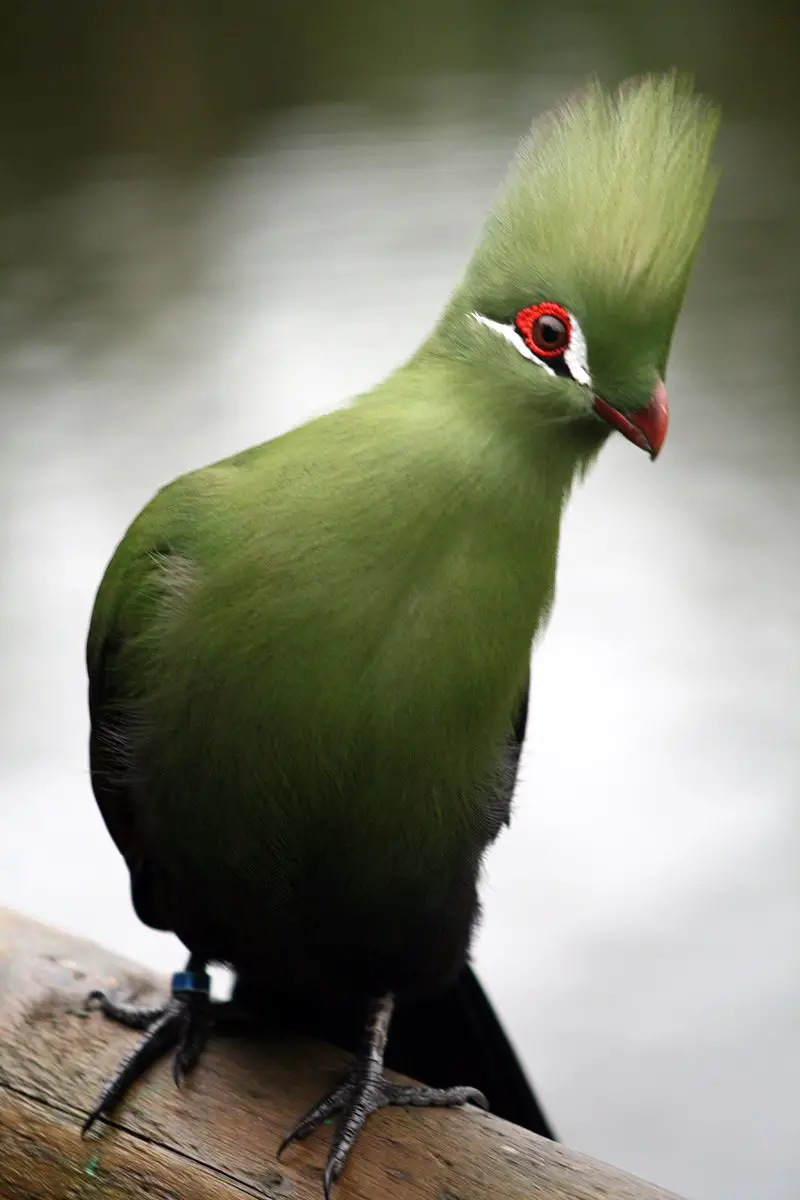
Turacos are a unique bird family that inhabit tropical and subtropical regions of Africa. They are also known as “banana-eaters” or “loeries” in southern Africa, due to their diet which consists mostly of fruit such as plantains.
These birds have an interesting semi-zygodactylous foot structure – the fourth toe can be switched back and forth while the second and third toes remain conjoined.
Turacos come in different sizes depending on species but they all generally boast bright colors like green, blue, purple or red feathers with vibrant yellow eyes.
In addition to being beautiful creatures, these birds make loud calls during mating season which makes them even more special.Scientific classification:
| Kingdom | Animalia |
| Phylum | Chordata |
| Class | Aves |
| Clade | Otidimorphae |
| Order | Musophagiformes Seebohm, 1890 |
| Family | Musophagidae Lesson, 1828 |
12. Green Wood Hoopoe
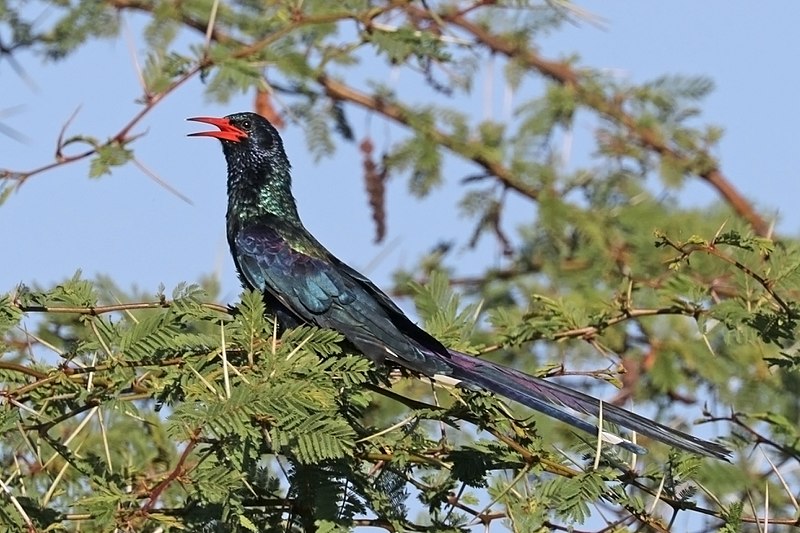
The Green wood hoopoe is a beautiful species of bird native to Africa. It measures up to 44 cm in length, and has distinctively bright green feathers with a purple back and long tail.
Its wings are marked with white, adding further distinction to this vibrant creature.
This abundant species can be found living among the trees of tropical forests across its range – it gets its name from their habit of using sticks and twigs for nest building purposes.
The Green wood hoopoe enjoys eating insects such as beetles, crickets, grasshoppers, moths and caterpillars; they also feed on small reptiles like lizards or snakes when available.
They are known for their loud call which sounds much like “oop-oop” echoing through the forest canopy – making them quite easy to spot.Scientific classification:
| Kingdom | Animalia |
| Phylum | Chordata |
| Class | Aves |
| Order | Bucerotiformes |
| Family | Phoeniculidae |
| Genus | Phoeniculus |
| Species | P. purpureus |
Also Featured In: Birds that You’ll Find in Kruger national park, Birds You’ll Find in Kenya Safari
13. African Openbill
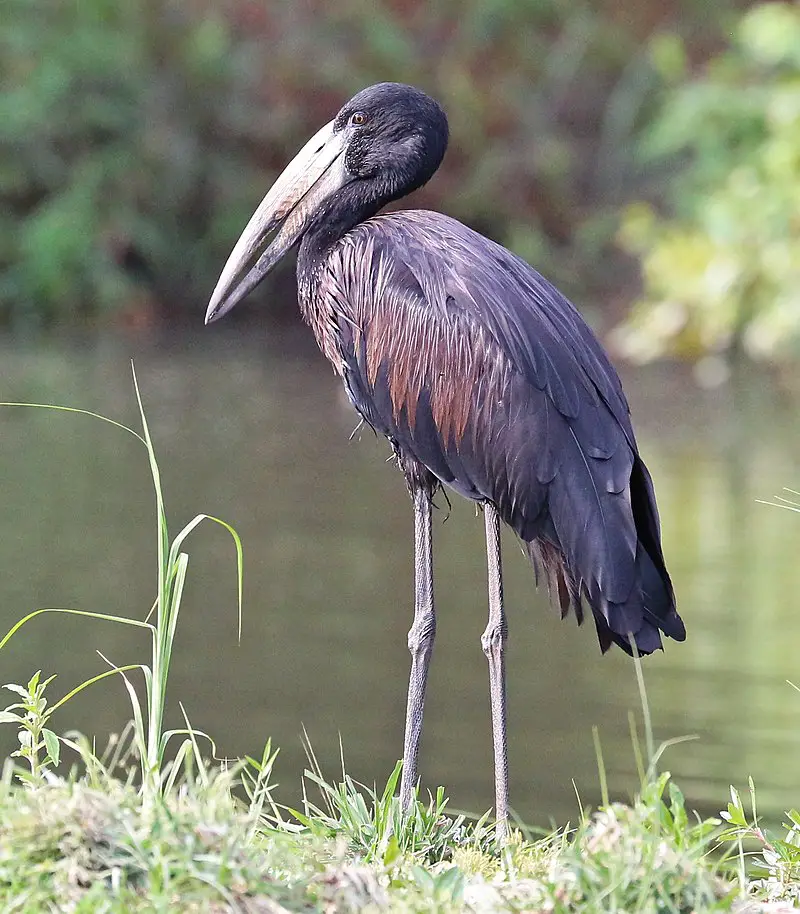
The African openbill is a species of stork found in Sub-Saharan Africa and western Madagascar.
It has a patchy distribution but is generally considered to be common or locally abundant, with two subspecies – A. l. lamelligerus on the continent and A. l. batesi in some parts of Madagascar’s west coast region.
This bird stands up to 75 cm tall and has an impressive bill that looks like it’s been cut down the middle when opened wide.
Its black feathers are contrasted by bright yellow legs, pinkish red eyes, and white wing tips which make it easily recognizable from other species of birds.
It feeds mainly on snails found amongst aquatic vegetation so can often be seen wading through shallow waters looking for food as well as perched atop trees scanning its surroundings for prey items.Scientific classification:
| Kingdom | Animalia |
| Phylum | Chordata |
| Class | Aves |
| Order | Ciconiiformes |
| Family | Ciconiidae |
| Genus | Anastomus |
| Species | A. lamelligerus |
14. Red-Shouldered Cuckooshrike
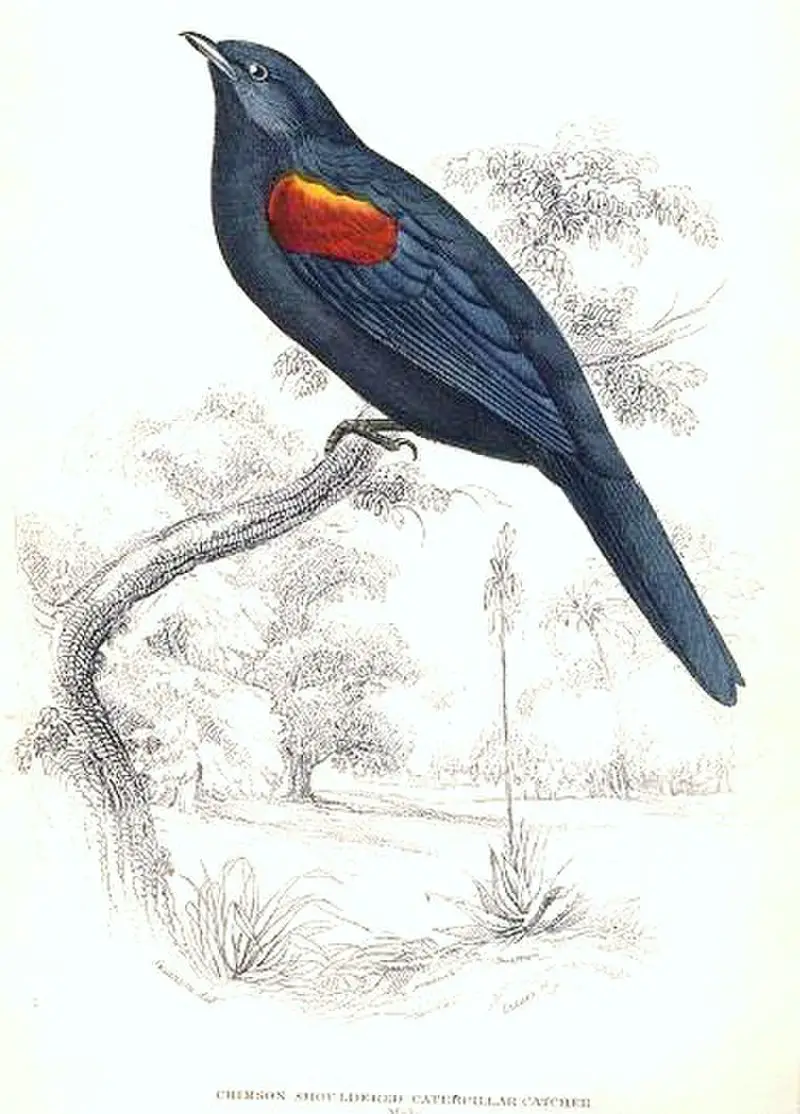
The Red-shouldered Cuckooshrike is a beautiful species of bird that can be found in many parts of Africa. Its feathers are deep red and black with an unmistakable white patch near the wings.
This unique coloration makes it easily recognizable among other birds, even when seen from far away. It has adapted to live in diverse habitats ranging from savannahs to forests and grasslands, so its population size remains stable despite threats like habitat loss or hunting pressure.
The diet consists mainly on insects and fruits, which they find while foraging around foliage during the day time hours. They also form strong bonds within pairs or family units as they share nests between them all year round. All these traits make this remarkable animal one worth appreciating and protecting for future generations to come.Scientific classification:
| Kingdom | Animalia |
| Phylum | Chordata |
| Class | Aves |
| Order | Passeriformes |
| Family | Campephagidae |
| Genus | Campephaga |
| Species | C. phoenicea |
15. Speckled Pigeon
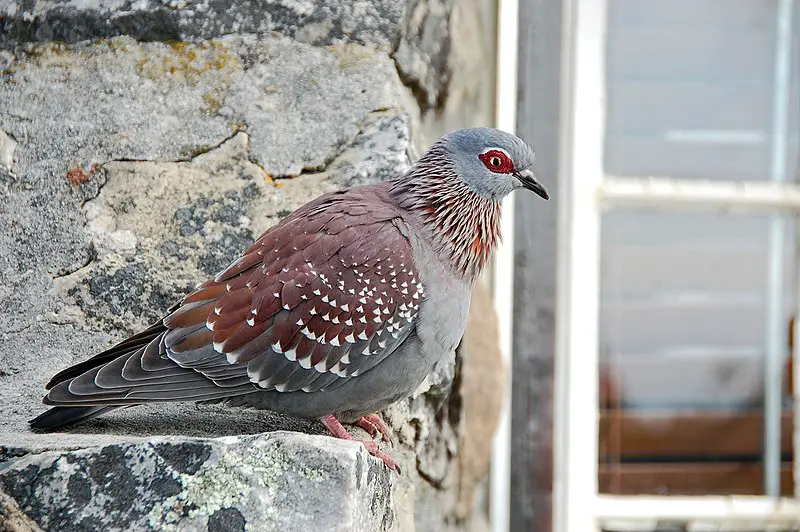
The Speckled Pigeon, also known as the African Rock Pigeon or Guinea pigeon due to its similar coloring to some species of guineafowl, is a resident breeding bird in much of Africa south of the Sahara.
It’s commonly seen inhabiting open habitats and has been around since 1747 when it was first described by Swedish naturalist Carl Linnaeus.
These birds usually have grey bodies with speckles on their wings, although they can vary from brownish-grey to dark slate blue depending on where they’re found geographically.
They feed mostly on seeds and other grain crops but will sometimes supplement that diet with insects if available.
In general these pigeons are harmless unless threatened – so be sure not to startle them.Scientific classification:
| Kingdom | Animalia |
| Phylum | Chordata |
| Class | Aves |
| Order | Columbiformes |
| Family | Columbidae |
| Genus | Columba |
| Species | C. guinea |
16. Northern Red-Billed Hornbill
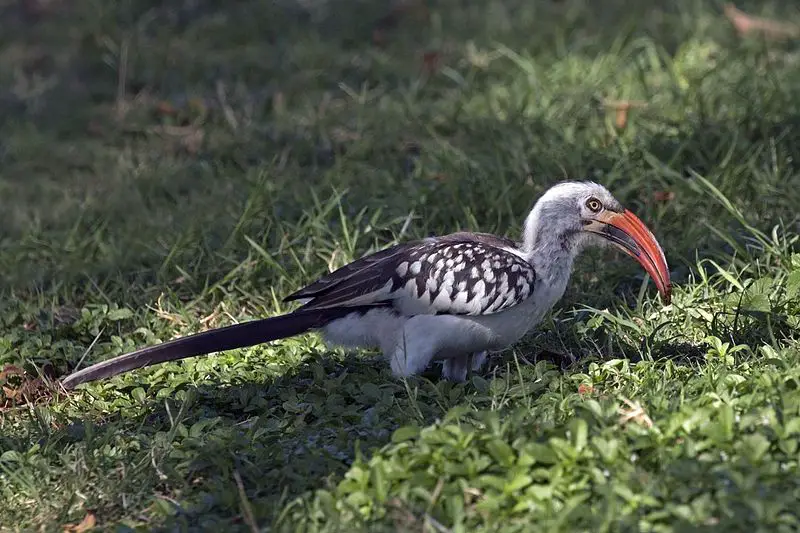
The Northern Red-billed Hornbill is a species of bird belonging to the Bucerotidae family. It can be found in many countries across Africa, from Mauritania through Somalia and Northeast Tanzania.
This hornbill has five recognized subspecies, though all were once considered part of one single species. The northern red-billed hornbill have distinctive black feathers on their body with deep yellow around its eyes and crest.
Its bill and legs are bright red while they feature an impressive casque at the top of it’s head that helps amplify calls during mating season or as a signifier for territoriality towards other birds.
They feed mainly on fruits such as figs but also enjoy insects like moths or beetles when available.Scientific classification:
| Kingdom | Animalia |
| Phylum | Chordata |
| Class | Aves |
| Order | Bucerotiformes |
| Family | Bucerotidae |
| Genus | Tockus |
| Species | T. erythrorhynchus |
17. Black-Bellied Bustard
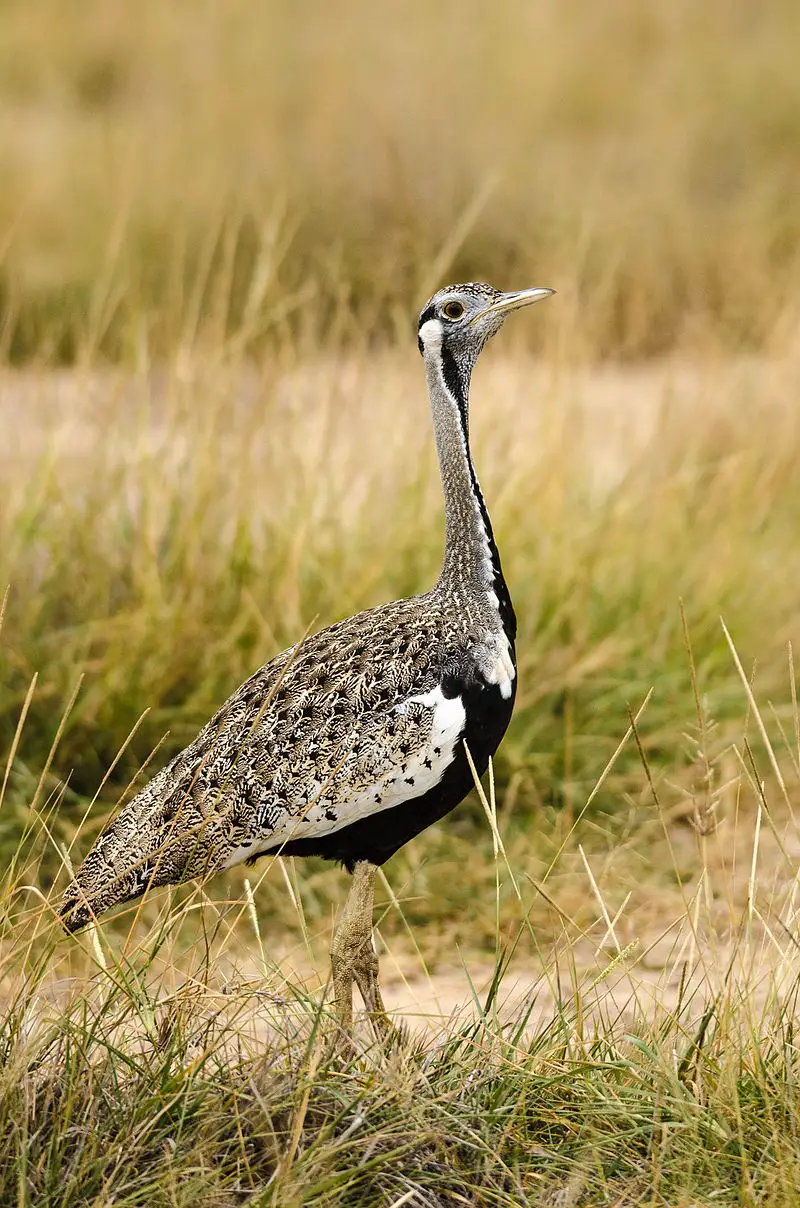
The black-bellied bustard is a fascinating bird, native to Africa. It belongs to the Bustard family and measures between 58–65 cm (23–26 in) long.
This beautiful creature has tawny buff upperparts with black and brown marks on it, while its underparts are entirely black.
Its head stands out due to bold patterns of white, buff and black feathers which make for an impressive sight. The bill and legs of the Black-bellied Bustards have dull yellow coloration.
These birds live on the ground rather than in trees or bushes like other members of their species usually do – making them quite unique among African birds.
They can be found mostly in grasslands where they feed mainly on insects as well as small rodents occasionally too.Scientific classification:
| Kingdom | Animalia |
| Phylum | Chordata |
| Class | Aves |
| Order | Otidiformes |
| Family | Otididae |
| Genus | Lissotis |
| Species | L. melanogaster |
Also Featured In: East African Birds, Birds that Live in lake Mburo National Park
18. Northern Carmine Bee-Eater
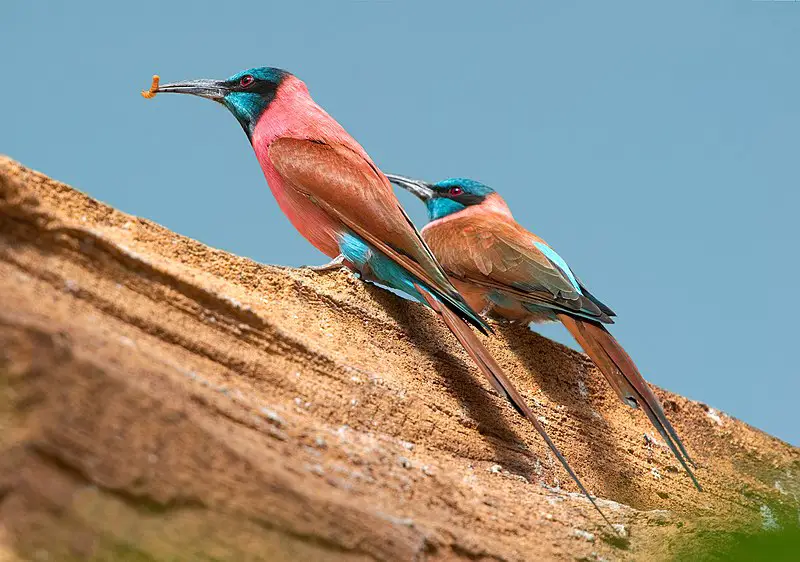
The Northern Carmine Bee-eater is a beautiful bird with striking colors. It has bright red and blue plumage, with the throat being predominantly carmine in color.
This species of bee-eater can be found throughout northern tropical Africa, from Senegal east to Somalia, Ethiopia and Kenya.
It was previously assumed to be closely related to the Southern Carmine Bee-eater which has a scarlet colored throat instead of blue as seen in this species.
The Northern Carmine Bee-Eater feeds on flying insects such as bees and other small creatures that it catches midair using its sharp claws and bill for grabbing them quickly before they escape.Scientific classification:
| Kingdom | Animalia |
| Phylum | Chordata |
| Class | Aves |
| Order | Coraciiformes |
| Family | Meropidae |
| Genus | Merops |
| Species | M. nubicus |
19. Senegal Thick-Knee
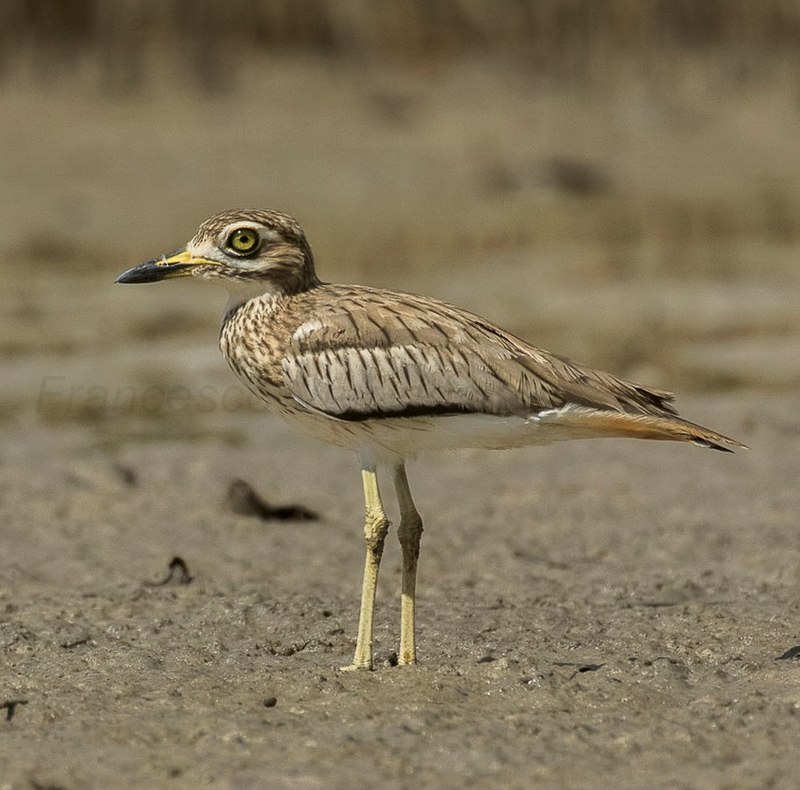
The Senegal Thick-Knee is a large wading bird found in Africa. It has long yellow or greenish legs with prominent joints and black and yellow beak. This species breeds between the Sahara Desert to the equator, as well as in the Nile Valley, making it one of Africa’s most wide spread birds.
They are solitary creatures but can often be seen perching on fences or trees looking out for prey such as insects and small rodents which they hunt using their strong bills.
The Senegal thick-knee also feeds on carrion, scavenging food from other animal sources when available. During breeding season these birds become more vocal, producing loud calls that can travel across miles of open terrain so they can attract mates and establish territories.
Overall this unique African resident provides an important link in its local ecosystem by providing both food resources for predators while keeping insect populations under control through hunting activities..Scientific classification:
| Kingdom | Animalia |
| Phylum | Chordata |
| Class | Aves |
| Order | Charadriiformes |
| Family | Burhinidae |
| Genus | Burhinus |
| Species | B. senegalensis |
20. Standard-Winged Nightjar
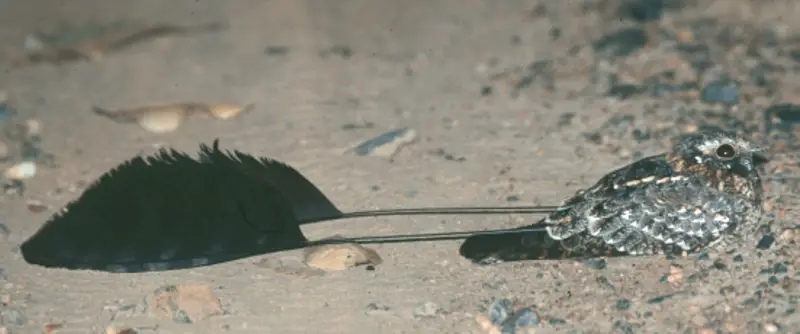
The Standard-winged nightjar is a nocturnal bird belonging to the nightjar family. It can be found in dry savannah habitats and some scrub across Africa, from Senegal east to Ethiopia.
During breeding season, adult males have an unusual wing ornament consisting of a broad central flight feather on each wing that elongates up to 38 centimetres (15 inches).
They also boast distinctive black throats with white spots which contrast against their brown and grey plumage.
The wings’ undersides are marked by two whitish bars while white patches at the base of its tail add further detail when in flight. In addition, they possess large eyes adapted for hunting food such as insects during twilight hours whilst keeping still and silent like other members of this secretive species.Scientific classification:
| Kingdom | Animalia |
| Phylum | Chordata |
| Class | Aves |
| Order | Caprimulgiformes |
| Family | Caprimulgidae |
| Genus | Caprimulgus |
| Species | C. longipennis |
21. Denham’s Bustard
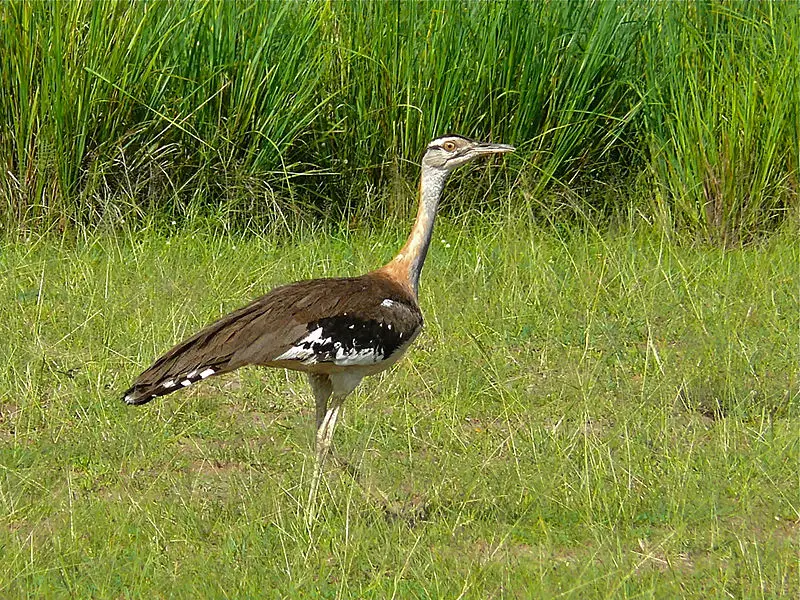
Denham’s bustard is a large bird belonging to the Bustard family found in Sub-Saharan Africa. It inhabits open ground including agricultural land, grassland and floodplains.
This species is resident but some inland populations move down south during winter season for better climate conditions.
The common names used for this species are dedicated to an English explorer called Stanley who first discovered it in 1841 while travelling across Central African Republic region.
Denham’s bustards have strong legs which help them take off quickly from the ground due to their heavy body weight of 2–3 kgs on average with wingspan ranging up till 140 cm long.
They feed mostly upon insects, rodents and seeds making them omnivorous birds.
These birds usually live solitary lives or forms small flocks when migrating but come together during breeding seasons as they build their nests close by each other and mate around same time period too.Scientific classification:
| Kingdom | Animalia |
| Phylum | Chordata |
| Class | Aves |
| Order | Otidiformes |
| Family | Otididae |
| Genus | Neotis |
| Species | N. denhami |
Also Featured In: Birds that Live in Benin,
22. Woodland Kingfisher
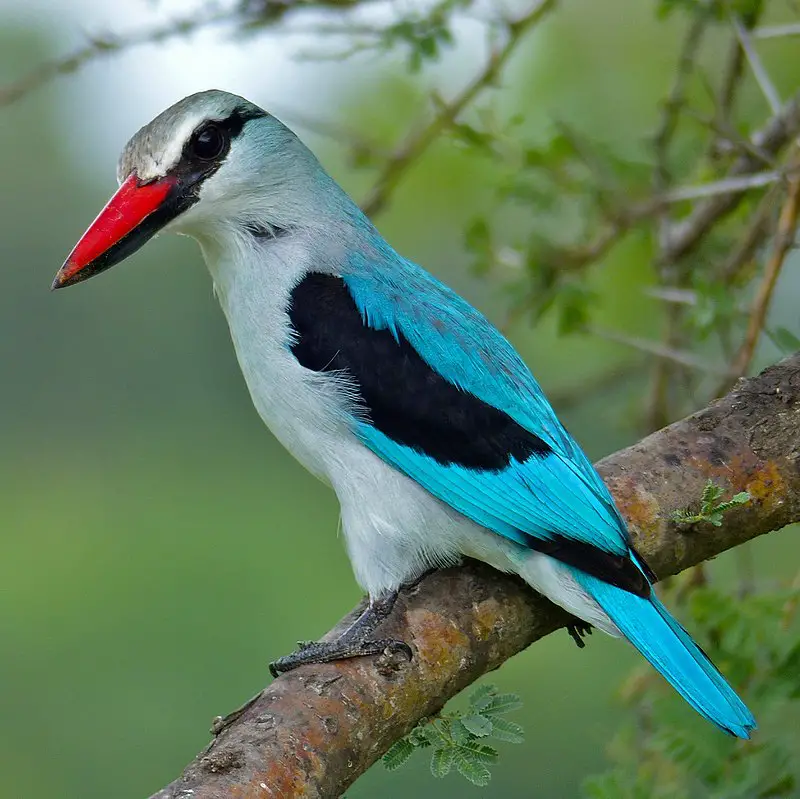
The Woodland Kingfisher is a beautiful bird, native to Africa south of the Sahara. It was first described in 1766 by Carl Linnaeus who called it Alcedo senegalensis.
This tree kingfisher has an attractive blue and white plumage with some red and black markings on its wings, tail and head.
The male also has a bright orange beak which helps to distinguish him from the female whose beak is yellowish-green.
These birds can usually be found in wooded areas near water sources such as rivers or lakes where they hunt for food including fish, frogs, small insects and even lizards.
They build their nests either high up in trees or inside holes dug out of banks near rivers and ponds.
Although not threatened yet, these lovely creatures need our protection so that future generations will have the chance to marvel at them too.Scientific classification:
| Kingdom | Animalia |
| Phylum | Chordata |
| Class | Aves |
| Order | Coraciiformes |
| Family | Alcedinidae |
| Subfamily | Halcyoninae |
| Genus | Halcyon |
| Species | H. senegalensis |
23. Blue-Breasted Kingfisher
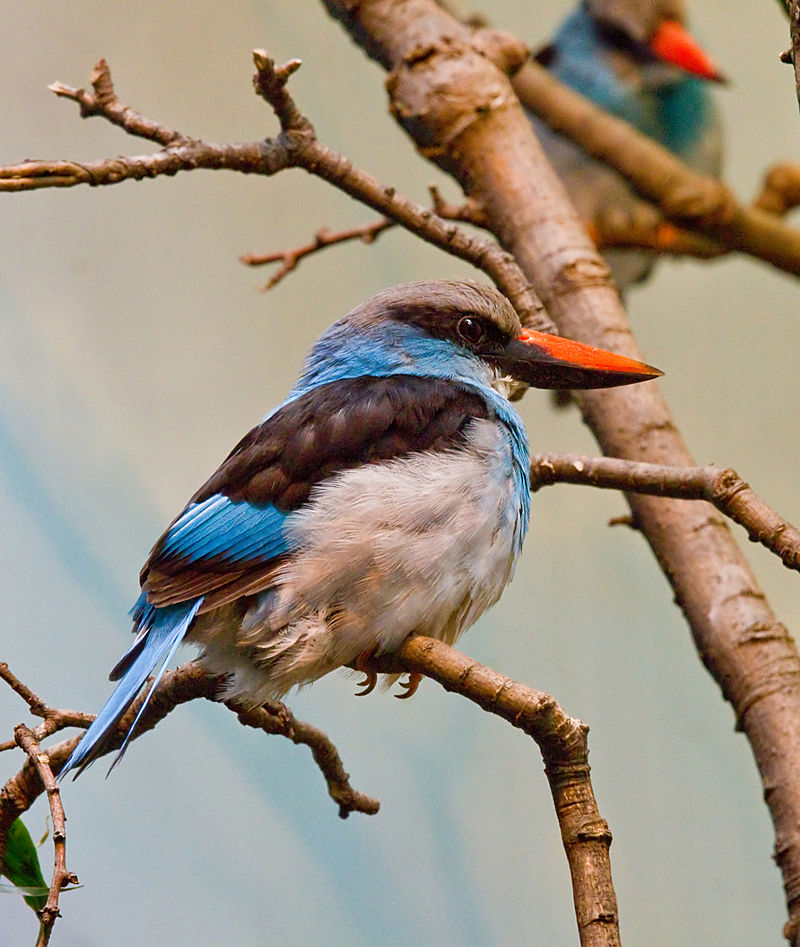
The Blue-breasted Kingfisher is a striking species of bird native to Equatorial Africa. Measuring 25 cm in length, this tree kingfisher has bright blue feathers on its head, back, wings and tail.
Its underparts are white with a contrasting blue breast band for added visual interest.
Though essentially resident there, it does migrate from drier savannas to wetter habitats during the dry season in order to survive better.
This species feeds mainly on insects such as beetles and grasshoppers but will also take small fish when available near the shorelines or riverside vegetation they inhabit.
The beautiful song of these birds can often be heard echoing through their natural environment – an unmistakable sound that makes them easily recognizable.Scientific classification:
| Kingdom | Animalia |
| Phylum | Chordata |
| Class | Aves |
| Order | Coraciiformes |
| Family | Alcedinidae |
| Subfamily | Halcyoninae |
| Genus | Halcyon |
| Species | H. malimbica |
24. Pearl-Spotted Owlet
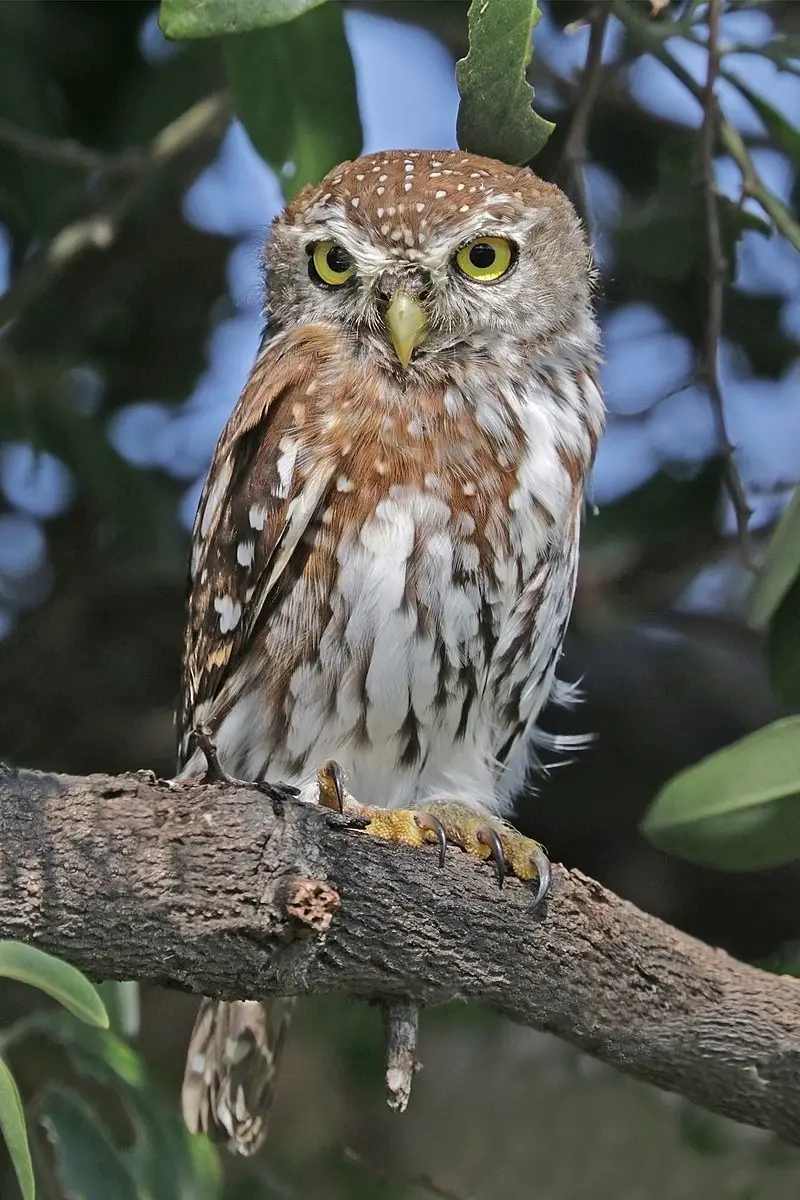
The Pearl-spotted Owlet is a small bird of prey that lives in sub-Saharan Africa. It belongs to the Strigidae family, which are commonly referred to as typical owls or true owls.
These birds have brown feathers with heavy spots, making them easily recognizable among other species of owl.
They usually measure between 14 and 16 centimeters long with an average wingspan of 28 centimeters wide.
Their diet consists mainly of insects such as moths and beetles but they also feed on frogs and small rodents occasionally.
During mating season males will use their sharp call for territorial purposes while females remain silent during this time period.
The female lays 2-4 eggs at one time before incubating them for around 3 weeks until hatching occurs after which both parents take part in feeding their young chicks until fledging age which is when they become independent enough to survive on their own in nature.Scientific classification:
| Kingdom | Animalia |
| Phylum | Chordata |
| Class | Aves |
| Order | Strigiformes |
| Family | Strigidae |
| Genus | Glaucidium |
| Species | G. perlatum |
25. Long-Tailed Nightjar
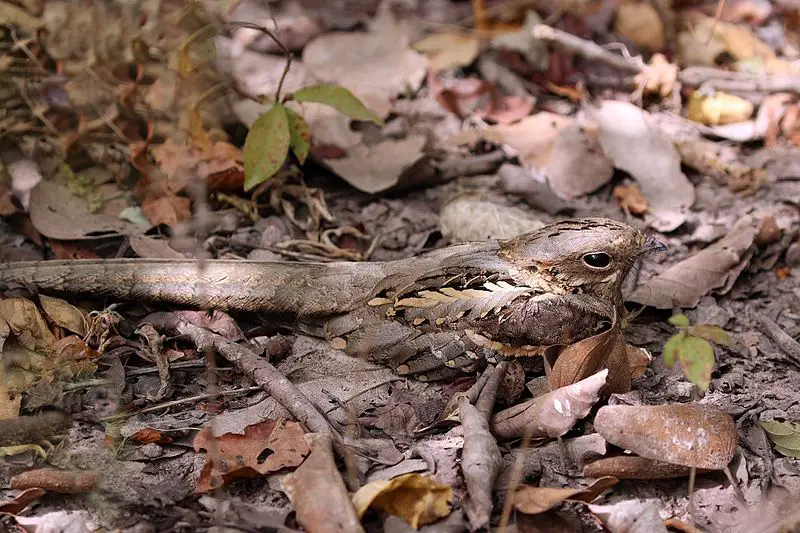
The Long-tailed Nightjar is a small bird native to multiple African countries. It belongs to the family of Caprimulgidae, and has large eyes which allows it to be active at night.
In addition, its wingspan can reach up to 25cm in length – making it one of the larger species within this group.
Its plumage consists mainly of greyish brown with darker markings on both upperparts and underparts; males also have white patches near their tail feathers for added camouflage during flight.
The long-tailed nightjar’s diet consists mostly of insects such as moths, dragonflies and beetles that they hunt from dusk until dawn by swooping down upon them before catching them midair or sipping nectar from flowers.
This nocturnal bird usually roosts in trees during day time but will sometimes use man made structures like telephone poles or buildings as well.Scientific classification:
| Kingdom | Animalia |
| Phylum | Chordata |
| Class | Aves |
| Order | Caprimulgiformes |
| Family | Caprimulgidae |
| Genus | Caprimulgus |
| Species | C. climacurus |
26. Splendid Starling
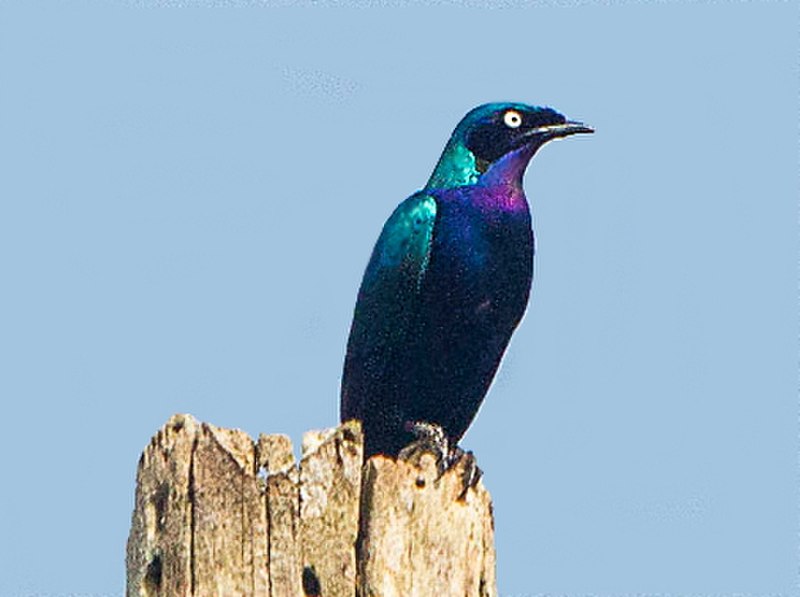
The Splendid Starling, also known as the Splendid Glossy-Starling, is a beautiful bird with glossy black feathers and blue iridescent highlights on its wings.
It resides in several African countries such as Angola, Benin, Botswana, Burundi and many more. Its diet consists mostly of insects but it has been known to eat grains and fruits.
The starlings often gather into large flocks which are loud during flight due to their chatterings. They build nests at the top of trees or buildings where they lay eggs that hatch after 11-13 days incubation period by both parents.
These birds have long been kept as pets because of their stunning appearance; however they require special care since they can become aggressive if not handled properly or when threatened in any way.
All in all these majestic creatures make for an enjoyable sight whether alone or gathered together.Scientific classification:
| Kingdom | Animalia |
| Phylum | Chordata |
| Class | Aves |
| Order | Passeriformes |
| Family | Sturnidae |
| Genus | Lamprotornis |
| Species | L. splendidus |
27. Striped Kingfisher
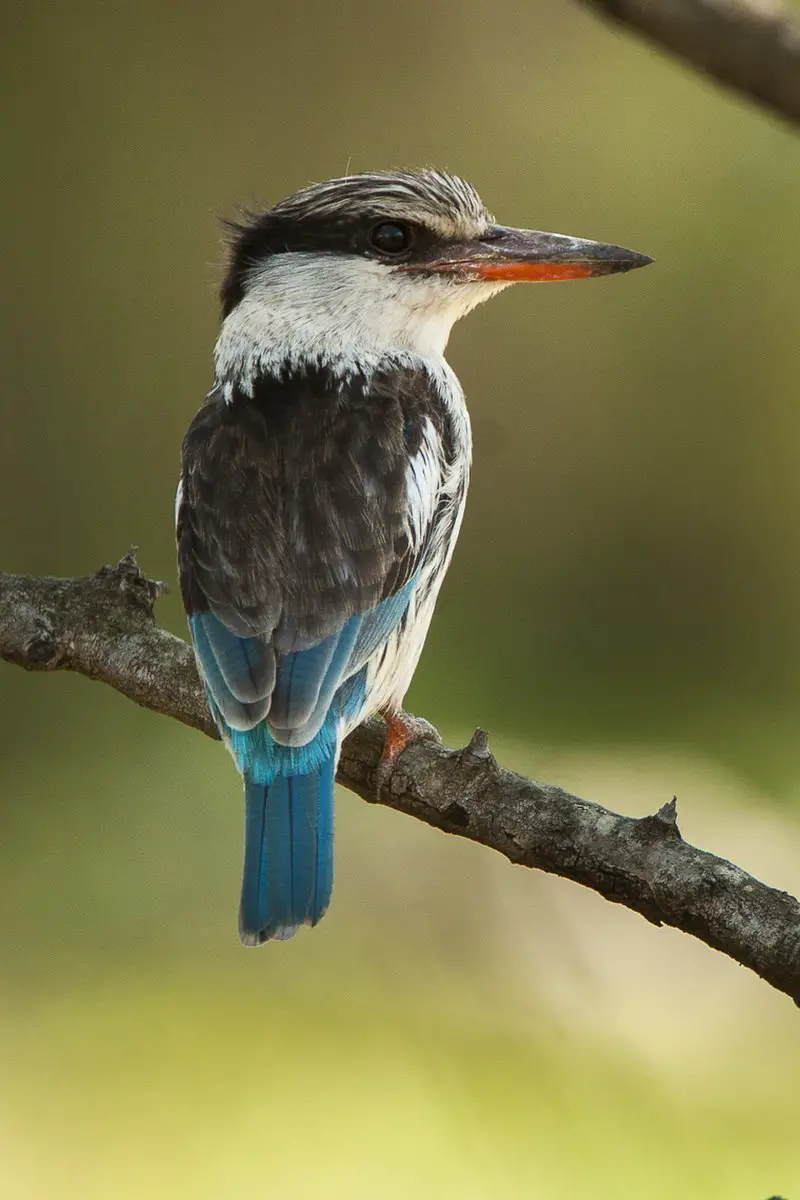
The Striped Kingfisher is a species of bird in the tree kingfisher subfamily.
It was first described by Edward, Lord Stanley as Alaudo Chelicuti and its genus name Halcyon comes from an ancient Greek legend which associates it with the kingfisher.
This beautiful bird has distinctive black stripes on its back and wings, along with bright blue feathers covering most of its body.
The bill is large and stout while the legs are short but strong for perching on branches or diving into water to catch prey such as fish or crustaceans.
Its call consists of loud chirps that can be heard over long distances making it easy to identify in forests near streams or rivers during migration season when they travel through Africa towards Asia between October-March each year.Scientific classification:
| Kingdom | Animalia |
| Phylum | Chordata |
| Class | Aves |
| Order | Coraciiformes |
| Family | Alcedinidae |
| Subfamily | Halcyoninae |
| Genus | Halcyon |
| Species | H. chelicuti |
28. Little Weaver
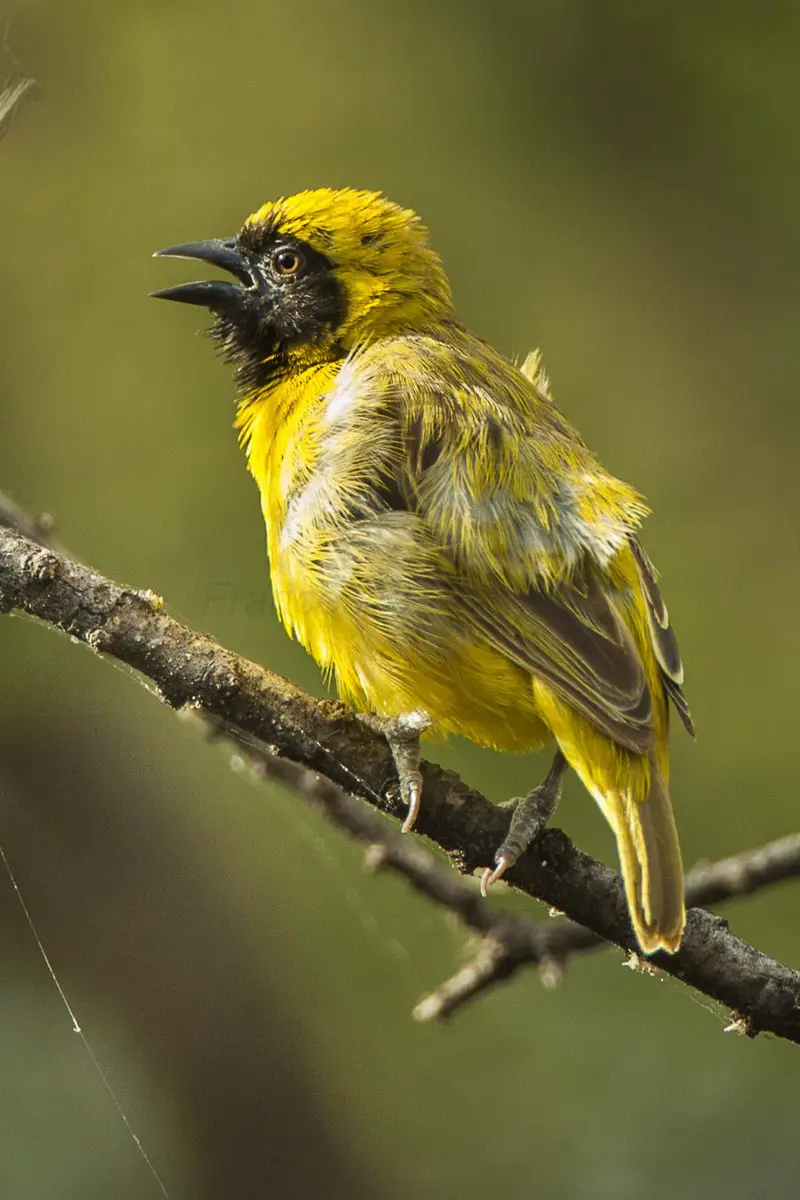
The Little Weaver is a species of bird found in western, central and eastern Africa. It has light brown upperparts with white underparts, chestnut flanks and wings barred with black.
Its head is yellowish-gray with dark streaks throughout its crown and nape area. The bill and legs are pinkish-brown while the eyes are reddish-brown. This species feeds mainly on seeds but will also consume insects if available.
They form monogamous pairs that build their nests out of dry grasses which they weave into intricate structures suspended from trees or other vegetation up to 3 meters off the ground; this gives them protection from predators as well as harsh weather conditions such as rain or heat waves during summer months.
These birds breed seasonally between late April until August depending on food availability in the region it inhabits making them an important part of many African ecosystems.Scientific classification:
| Kingdom | Animalia |
| Phylum | Chordata |
| Class | Aves |
| Order | Passeriformes |
| Family | Ploceidae |
| Genus | Ploceus |
| Species | P. luteolus |
29. Yellow-Crowned Gonolek
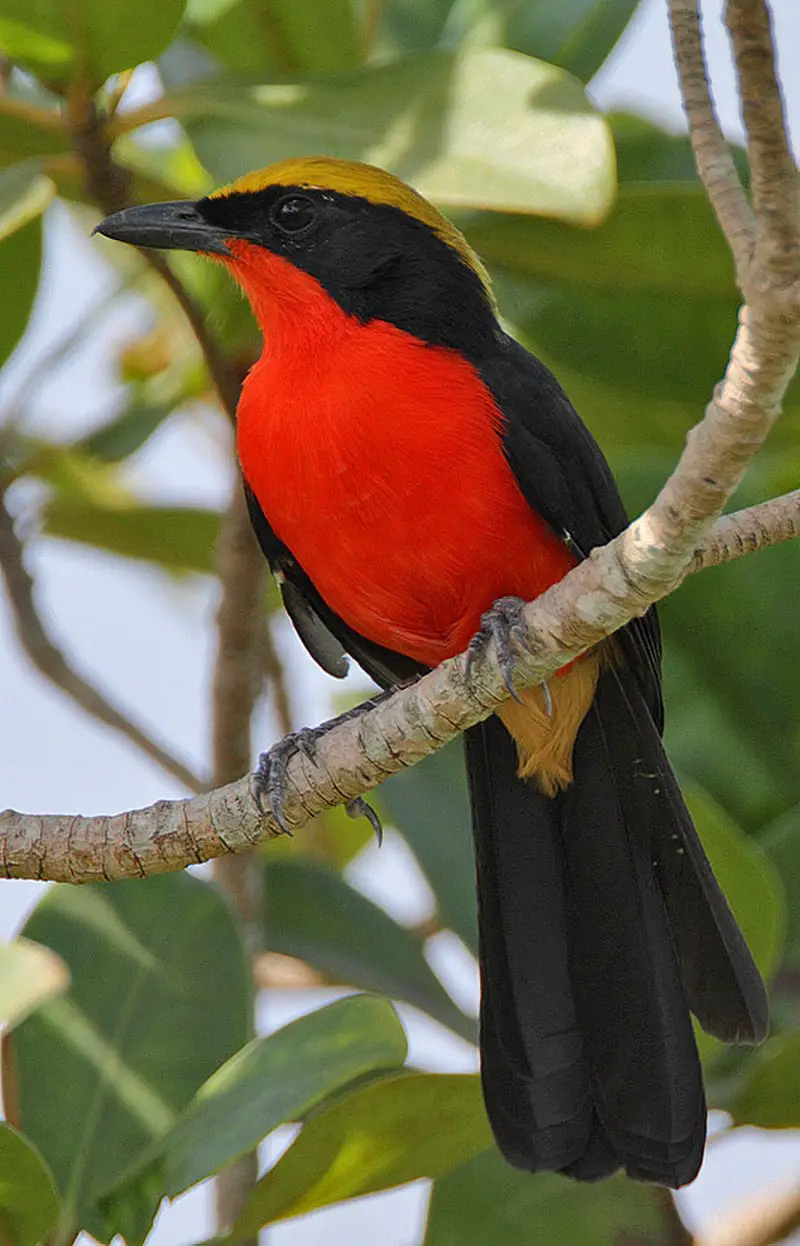
The Yellow-crowned Gonolek is a common resident bird of equatorial Africa, found from Senegal to Ethiopia. It lives in dense undergrowth and wooded habitats, typically nesting in cup structures within bushes or trees.
This medium-sized passerine has striking plumage consisting of black wings with white spots, a yellowish crown and nape, brown body feathers streaked with cream markings and orange legs.
Its diet consists mainly of insects such as grasshoppers and caterpillars which it hunts by scanning the ground while perched on branches or flying low over vegetation searching for prey items.
The call of this species is an unmistakable loud “weeoo” often heard early morning when they are most active.
These birds form monogamous pairs that breed year round depending upon environmental conditions resulting in clutches containing up to five eggs being laid each seasonScientific classification:
| Kingdom | Animalia |
| Phylum | Chordata |
| Class | Aves |
| Order | Passeriformes |
| Family | Malaconotidae |
| Genus | Laniarius |
| Species | L. barbarus |
30. African Jacana
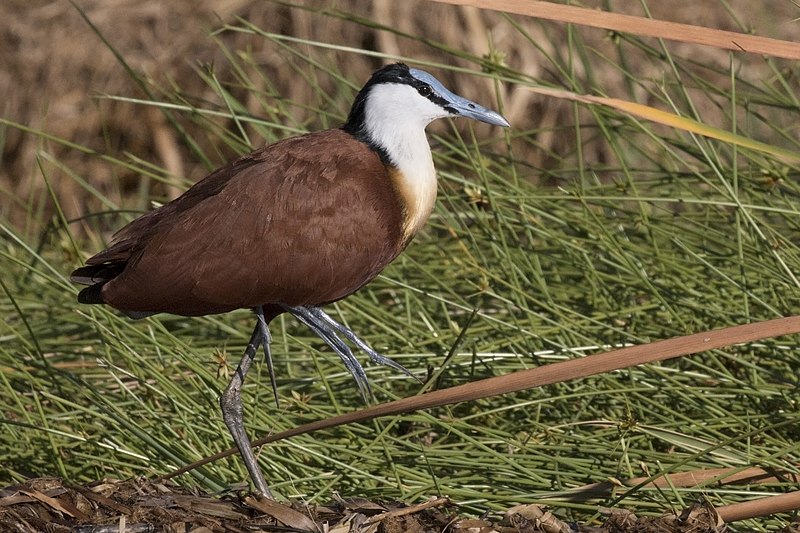
The African Jacana is a charming wader belonging to the family of Jacanidae, mostly found in sub-Saharan Africa.
It has long toes and claws that allow it to walk on floating vegetation in shallow lakes which form its preferred habitat.
The bird was officially described by Johann Friedri in 1789 with an interesting origin and pronunciation for its name -Jacanidae.
This aquatic bird is known for its striking plumage features like yellow crowns and black wings marked with chestnut brown stripes across them, making them look even more attractive when they spread their wing feathers during courtship displays.
They feed mainly on insects, tadpoles, frogs etc., skimming nearby water surface or plucking prey from vegetation as they wander around these wetlands areas.Scientific classification:
| Kingdom | Animalia |
| Phylum | Chordata |
| Class | Aves |
| Order | Charadriiformes |
| Family | Jacanidae |
| Genus | Actophilornis |
| Species | A. africanus |